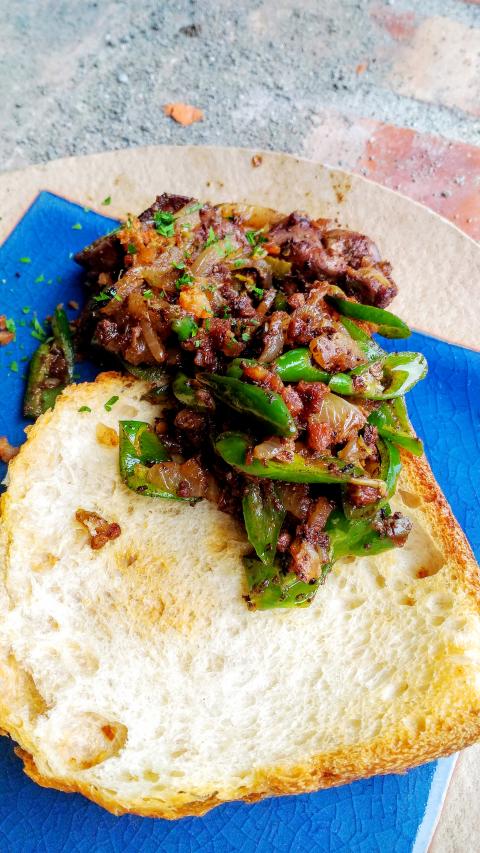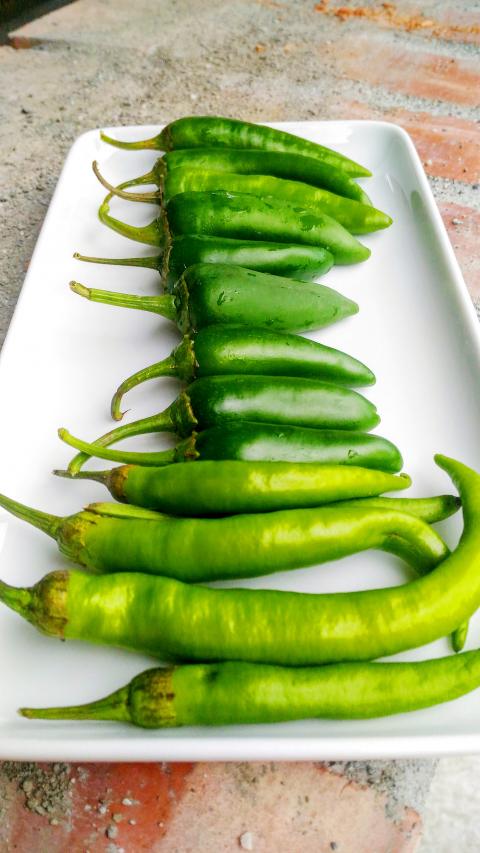Most people tend to associate the heat and pungency of chili with the color red. A Thai red curry screams hot spiciness even before you have tasted it, and you can easily have a deep red dish such as chicken cacciatore, which is made sweet and luscious with the use of red bell peppers. So green chilies, which range in flavor from mild sweetness to blistering, mouth-burning spiciness can serve up some unwelcome surprises. In Taiwan, were vegetables are not always clearly labeled, it is always best to ask your grocer what you might expect, or taste a little bit before seasoning your dish just to see where your particular chili ranks on the spiciness scale.
These reflections were prompted by watching an exchange at my local market between a customer and an Aboriginal woman at my usual vegetable stall. The question was: Were the chilies hot? “Not at all!” came the response, the stallholder eager to move her produce. But before the customer could pay, another of the costermongers piped up, “Those are quite hot, actually!” The bag of chilies was replaced, and meanwhile an energetic discussion ensued on the hotness of those particular chilies.
I never found out if those chilies were ever sold to that particular customer, but when I got my own bag of chilies back home, I found they were of a middling heat that suited my palate very nicely. These were fat, stubby green chilies that have a look very similar to jalapenos, and may very well be of the same variety. They are certainly well suited to pickling, and in Hualien make their appearance as “peeled chilies” (剝皮辣椒), which are sold in stores specializing in local “specialties.” These Taiwanese pickled chilies can be remarkably tasty, and while they might not do justice to a pulled pork sandwich, they can make a delightful meal of white rice, a fried egg and soy sauce if you have nothing else on hand. A dozen chopped and added to egg fried rice gives the dish a nice Southeast Asian tang that works brilliantly with a bit of Indonesian sweet soy (ketjup manis).

Photo: Ian Bartholomew
It is worth noting that the quality of these pickles varies wildly and you probably won’t be getting anything much if you are picking up a few jars in a specialty store on the No. 9 Expressway, so as with any food products, it is always best to seek out a reputable manufacturer. Good “peeled chilies” give depth of flavor as well as heat, while second-rate products tend to taste of little more than soy and sugar.
These green chilies, let us call them jalapenos for convenience, have a gentle heat that can be tamed further by removal of the seeds and ribs, and have a rich herbal flavor that can enhance the savor of many a dish. I speak as a chili lover who finds the tongue tingling and belly warming properties of any chili something to cherish, but Taiwan’s jalapenos might be regarded as an excellent gateway drug to those finding their way into the sick world of culinary heat-seekers.
There are those who seek out massive blasts of heat from chilies, and while these jalapenos can stand tall in the ranks of chili power, managing to marshal 2,500 to 5,000 Scoville heat units, the official scale of the chili heat, the same as original Tabasco brand pepper sauce, according to chiliworld.com (www.chiliworld.com). The bird’s eye chili, which is also widely available in Taiwan, scores between 100,000 to 225,000 units on this scale, is also delicious when prepared correctly. For comparison, defensive pepper spray scores 2 million units, but you really don’t want to be eating that stuff for dinner unless you have some serious pain issues. (To scratch that itch, the Da’ Bomb The Final Answer, a hot sauce that scores 1.5 million units but is nevertheless intended for consumption as a condiment.)

Photo: Ian Bartholomew
All that said, the Taiwan jalapeno is a relatively mild creature and can be enjoyed as a wonderful vegetable through the summer months, and is especially useful in helping to strengthen the immune system. It soothes the respiratory system and is rich in Vitamin E, which is good for the skin. Its natural anti-inflammatory properties are widely regarded as able to inhibit the rashes and itchiness that are often part of many people’s experience of Taiwan’s humid summers.
But the main thing is that green chilies are a really a very different beast from red chilies (previously covered in this column, June 25, 2015). As with red chilies, they can be simply chopped up and added to soy sauce as a lovely condiment, and as a pickle they are a marvelous standby, but now that they are available fresh, make the most of them.
Chicken Liver Picante
(serves two)
This dish is equally suitable as a late night snack or late morning brunch, with plenty of piquancy to stimulate a jaded pallet or weary digestive system. It is a doddle to make, inspired as it is by another favorite restorative meal of mine, spaghetti alla puttanesca (roughly translated as “working girl’s pasta”), using simple ingredients that are usually in the fridge (small packets of chicken livers freeze well and defrost quickly). There are times when a trip out to the market for fresh veg just seems too much of an effort, and this dish is a product of such slatternly moods, and is just as good with an ass-end of a sliced white loaf as with fresh baguette from your local artisanal boulangerie.
Ingredients
200g chicken livers
100g green chilies
1 small onion, sliced
1 thick rashers of salt pork, or bacon
1 tbsp capers, minced
2 tbsp dry sherry
Salt and pepper
Vegetable oil
Directions
1. Clean the livers by removing the connective veins and wash well under cold water. Drain well, then pat dry with kitchen paper.
2. Remove the seeds from the green chilies and chop roughly.
3. Chop the bacon roughly. Place in a cold skillet with a drizzle of oil and allow to render until golden and turning crisp. Set aside the bacon.
4. Drain off some of the bacon oil if there is too much (a situation I have rarely encountered, but that is a matter of personal taste). Add the onion and cook over low heat until the onions start to gain color. As the onion starts to release liquid, this is a good time to remove any bits sticking to the bottom of the skillet, mixing it into the onion.
5. Add the chili and fry for another 3-4 minutes until the chili begins to soften. Remove the onion and chili mixture to a bowl.
6. Heat some vegetable oil in the same skillet then add the livers. Allow to sit in the hot skillet for 30 seconds then turn over. Season with salt and pepper. Turn again after 30 seconds. The whole cooking process should not take more than 2 minutes, with the livers darkened on the outside but still pink in the middle. Turn off the heat.
7. Deglaze the skillet with a good slug of dry sherry (Shaoxing wine is a decent local substitute), releasing any bits stuck to the bottom of the skillet with a spatula. Pour in the onion mixture.
8. Mix in the capers and season with more salt and pepper as required. Serve with crispy toast.
Ian Bartholomew runs Ian’s Table, a small guesthouse in Hualien. He has lived in Taiwan for many years writing about the food scene and has decided that until you look at farming, you know nothing about the food you eat. He can be contacted at Hualien202@gmail.com.

April 28 to May 4 During the Japanese colonial era, a city’s “first” high school typically served Japanese students, while Taiwanese attended the “second” high school. Only in Taichung was this reversed. That’s because when Taichung First High School opened its doors on May 1, 1915 to serve Taiwanese students who were previously barred from secondary education, it was the only high school in town. Former principal Hideo Azukisawa threatened to quit when the government in 1922 attempted to transfer the “first” designation to a new local high school for Japanese students, leading to this unusual situation. Prior to the Taichung First

Chinese Nationalist Party (KMT) Chairman Eric Chu (朱立倫) hatched a bold plan to charge forward and seize the initiative when he held a protest in front of the Taipei City Prosecutors’ Office. Though risky, because illegal, its success would help tackle at least six problems facing both himself and the KMT. What he did not see coming was Taipei Mayor Chiang Wan-an (將萬安) tripping him up out of the gate. In spite of Chu being the most consequential and successful KMT chairman since the early 2010s — arguably saving the party from financial ruin and restoring its electoral viability —

The Ministry of Education last month proposed a nationwide ban on mobile devices in schools, aiming to curb concerns over student phone addiction. Under the revised regulation, which will take effect in August, teachers and schools will be required to collect mobile devices — including phones, laptops and wearables devices — for safekeeping during school hours, unless they are being used for educational purposes. For Chang Fong-ching (張鳳琴), the ban will have a positive impact. “It’s a good move,” says the professor in the department of

Article 2 of the Additional Articles of the Constitution of the Republic of China (中華民國憲法增修條文) stipulates that upon a vote of no confidence in the premier, the president can dissolve the legislature within 10 days. If the legislature is dissolved, a new legislative election must be held within 60 days, and the legislators’ terms will then be reckoned from that election. Two weeks ago Taipei Mayor Chiang Wan-an (蔣萬安) of the Chinese Nationalist Party (KMT) proposed that the legislature hold a vote of no confidence in the premier and dare the president to dissolve the legislature. The legislature is currently controlled